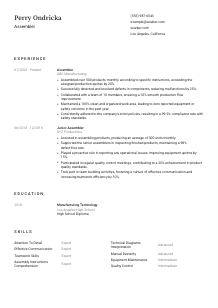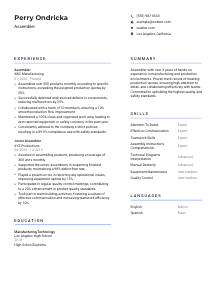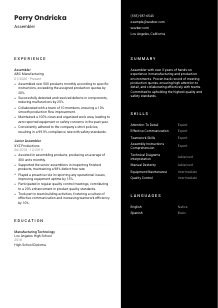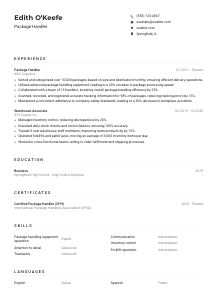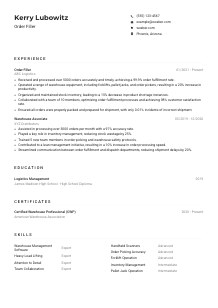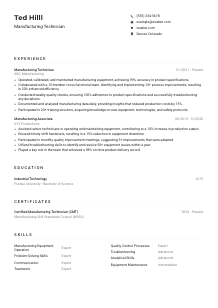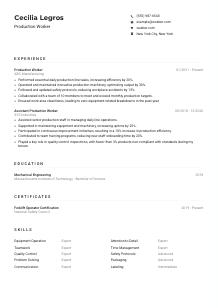Assembler Resume Example
Fitting cogs and connectors, but your resume just won't snap together? Check out this Assembler resume example, riveted with Wozber free resume builder. Discover how to thread your assembling skills to match job specifications, bringing your career into a seamless integration!
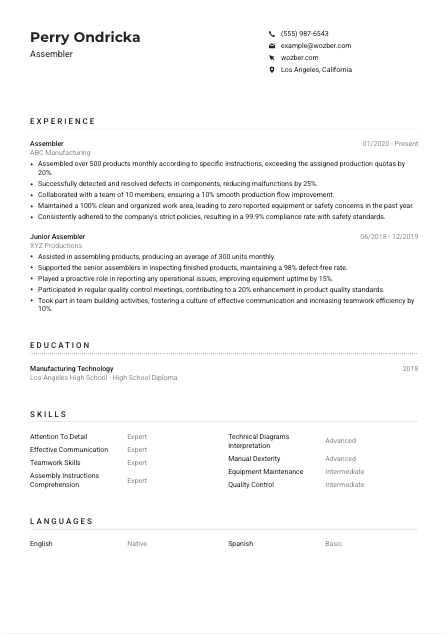
How to write an Assembler Resume?
As an Assembler gearing up for your next role, your resume isn't just a document; it's a tool of precision reflecting your meticulous nature. Using the Wozber free resume builder to tailor your resume to a specific job description, this guide will steer you through creating a compelling narrative that lands you the job. Are you ready to align your skills with your ambitions? Let's engineer a resume that assembles your career goals into reality.
Personal Details
The Personal Details section is your blueprint for success. As a skilled Assembler, you know the importance of getting every detail right. Here's how to calibrate this section for the Assembler position, ensuring it not only fits the technical requisites but also sets the stage for your introduction.
1. Make Your Name Your Brand
Think of your name as the logo of your personal brand. Highlight it with a clean, bold font to ensure it grabs attention. Remember, this is the first component an employer engages with, so make it count.
2. Align With Your Job Title
Directly below your name, specify that you're applying for the Assembler role. This instant role recognition acts like threading a needle – it connects your potential employer's needs with your capabilities right at the starting point.
3. Precisely Present Your Contact Info
Include only your most current and accessible contact details. This includes a professional email and a phone number. Accuracy here is crucial – think of it as ensuring all parts are correctly aligned before assembly begins.
4. Anchor Your Resume with Your Location
"Located in Los Angeles, California," places you immediately within the desired geographical zone, eliminating any relocation concerns for the employer. It's about positioning yourself in the right place at the right time.
5. Simplify Additional Details
Keep additional information such as LinkedIn profiles streamlined and relevant. Ensure your LinkedIn is a mirror reflection of your resume, showcasing a coherent professional image.
Takeaway
The Personal Details section lays the foundation of your resume. Like the first step in the assembly line, getting this right sets the tone for the entire document. Take the time to ensure each detail is precisely placed, as accuracy here reflects positively on your craftsmanship.





Experience
This is where your resume starts to take shape, much like a product moving along the assembly line. You have demonstrated your knack for precision in assembly tasks – now it's time to let these experiences shine.
- Assembled over 500 products monthly according to specific instructions, exceeding the assigned production quotas by 20%.
- Successfully detected and resolved defects in components, reducing malfunctions by 25%.
- Collaborated with a team of 10 members, ensuring a 10% smooth production flow improvement.
- Maintained a 100% clean and organized work area, leading to zero reported equipment or safety concerns in the past year.
- Consistently adhered to the company's strict policies, resulting in a 99.9% compliance rate with safety standards.
- Assisted in assembling products, producing an average of 300 units monthly.
- Supported the senior assemblers in inspecting finished products, maintaining a 98% defect‑free rate.
- Played a proactive role in reporting any operational issues, improving equipment uptime by 15%.
- Participated in regular quality control meetings, contributing to a 20% enhancement in product quality standards.
- Took part in team building activities, fostering a culture of effective communication and increasing teamwork efficiency by 10%.
1. Dissect the Job Description
Start with the provided job description. Pinpoint keywords and phrases such as "assembled products according to specific instructions" and "collaborated with team members." These are the components you'll need to build your experience section.
2. List Relevant Roles First
Structure your experiences to highlight your assembly work, starting with the most recent. Each role listed should act as proof of your capabilities, similar to passing quality control on the production floor.
3. Highlight Achievements with Precision
For each role, draft bullet points that reflect your accomplishments. Use the job description as a guide. Statements like "Assembled over 500 products monthly, exceeding production quotas by 20%" directly align with the job's demands.
4. Quantify Your Impact
Numbers speak volumes in manufacturing. By quantifying achievements, you give a clear, measurable indication of your impact and skill level. This is the equivalent of a product passing a stringent quality check.
5. Relevance is Key
Focus on experiences that are directly relevant to the assembly role. Unrelated achievements, while impressive, may distract from the core skills the employer is seeking. It's about showcasing the parts of your career that best fit the job's specifications.
Takeaway
Think of your Experience section as the main assembly line of your resume – every part needs to be in its right place, contributing to the overall product. Tailor it to reflect the job description while highlighting your key contributions and achievements. This section is the proof of your craftsmanship, so take the time to make it reflect the best of your abilities.
Education
For an Assembler, formal education establishes a foundational skill set, while on-the-job experience hones these skills to perfection. Here's how to ensure your educational background serves as a strong support structure for your resume.
1. Focus on the Fundamental Requirement
The job listing asks for a "High school diploma or equivalent." Make sure this fundamental requirement is clearly stated, positioning you as a qualified candidate from the start.
2. Keep the Structure Streamlined
List your educational credentials clearly and concisely. Start with the most recent, and ensure the formatting is uniform and easy to scan through – visualize this as arranging parts in a tray for easy access.
3. Match Job Specifications
If your degree is directly relevant to being an Assembler, make sure it's highlighted. For instance, a "High School Diploma in Manufacturing Technology," directly resonates with the role's requirements.
4. Mention Relevant Courses Optionally
For roles requiring specific technical skills, including relevant courses can bolster your qualifications, especially if you're in the early stages of your career.
5. Recognize Other Educational Achievements
While not always directly relevant, additional accolades like honors or specific projects can support your meticulous nature and attention to detail – valuable traits in assembly work.
Takeaway
Your educational background lays the foundational layer of your resume. It presents an overview of your technical knowledge and readiness for the role. Be clear, concise, and ensure it's tailored to meet the job specifics. Much like selecting the right tool for the job, choosing how to present your education can significantly impact your success.
Skills
The skills section is your opportunity to showcase the precision tools in your professional toolkit. Let's curate this section to highlight the competencies that make you the perfect candidate for the job.
1. Decode the Blueprint
Start by extracting the hard and soft skills directly mentioned or implied in the job description. Skills like "attention to detail" and "manual dexterity" are your keywords here.
2. Highlight Relevant Skills
Carefully match your own skills with those listed in the job description. Prioritize them in your resume, presenting a compelling case for your candidacy.
3. Organize for Impact
Present your skills in a neat, organized manner. Use categories if necessary, separating technical skills from soft skills to make it easier for hiring managers to identify your strengths.
Takeaway
Your skills section is like showing off the best tools in your toolkit, making it clear you're well-equipped for the job. Choose skills that align with the job requirements, and organize them for maximum impact. This targeted approach not only demonstrates your fit for the role but also your attention to detail – a critical trait for any Assembler.
Languages
In an interconnected, global manufacturing environment, the ability to communicate in multiple languages can be a valuable asset. Here's how to effectively present your language skills in a way that enhances your resume.
1. Recall Job Language Needs
The job specifies a "high proficiency in English." Ensure this is clearly listed at the top of your language skills, directly fulfilling a primary requirement.
2. Prioritize Important Languages
After addressing the mandatory language requirement, list other languages you are proficient in. This shows your ability to adapt and potentially communicate in a diverse work environment.
3. Be Honest With Your Proficiency
Clearly state your level of proficiency in each language. Being transparent about your abilities ensures expectations are matched, and demonstrates integrity.
4. Consider the Global Impact
For roles within companies that have international reach, highlighting your multilingual skills can significantly boost your profile, showcasing your ability to engage in multi-faceted communication.
5. Acknowledge Your Global Potential
Every language you speak opens another door on the global stage. Recognizing and presenting your linguistic abilities underscores your readiness to operate in diverse environments.
Takeaway
In today's global manufacturing sector, every language you know can be a unique asset, enhancing your ability to connect and collaborate. Highlight your linguistic skills to not just meet but surpass the foundational requirements, positioning yourself as a valuable, versatile candidate ready to take on challenges in a global context.
Summary
Your summary is the final touch, the quality inspection before your resume is complete. It's your chance to encapsulate your professional identity and the unique value you offer.
1. Absorb The Job's Core
Revisit the job requirements to ensure your summary aligns perfectly. Emphasize your hands-on experience and proven track record in specifics like "meeting production quotas" and "ensuring high attention to detail."
2. Start Strong
Begin with a statement that clearly positions you within your field, emphasizing the breadth of your experience. "Assembler with 3+ years of hands-on experience" sets a solid foundation.
3. Highlight Key Qualifications
Weave in your most relevant skills and accomplishments, particularly those that resonate with the job's needs. This includes your ability to exceed production quotas and maintain quality standards.
4. Keep It Lean
Your summary should pack punch in 3-5 lines, offering a glimpse into your capabilities. It's like applying a final polish, ensuring everything is just right before the product leaves the factory floor.
Takeaway
Craft your summary with the precision of a skilled Assembler, aligning every detail with the role's requirements. Let it reflect your expertise and readiness to contribute meaningfully from day one. This succinct, compelling opener sets the stage for your potential employer to delve deeper, eagerly anticipating the strengths and skills listed in your resume.
Assembly Complete: Launching Your Journey
With your resume now precision-engineered to match the Assembler position's demands, you're ready to make a lasting impression on potential employers. Remember, your resume is a living document, a reflection of your ongoing growth and accomplishments. Regularly update and tailor it using Wozber's free resume builder, ATS-compliant resume formats, and ATS-friendly resume templates.
Let Wozber's ATS resume scanner ensure your resume not only reaches but resonates with hiring managers, paving the way for your next career milestone. The world of assembly awaits your expertise – go forth and build your future!

- High school diploma or equivalent required.
- Minimum of 1 year of experience in assembling products in a manufacturing or production environment.
- Strong attention to detail and manual dexterity skills.
- Ability to read and interpret technical diagrams and assembly instructions.
- Effective communication and teamwork skills.
- The role demands high proficiency in English.
- Must be located in Los Angeles, California.
- Assemble products according to specific instructions and meet production quotas.
- Inspect components and finished products for any defects or malfunctions.
- Collaborate with team members and supervisors to ensure smooth production flow.
- Maintain a clean and organized work area, and report any equipment or safety concerns.
- Adhere to all company policies, procedures, and safety standards.





